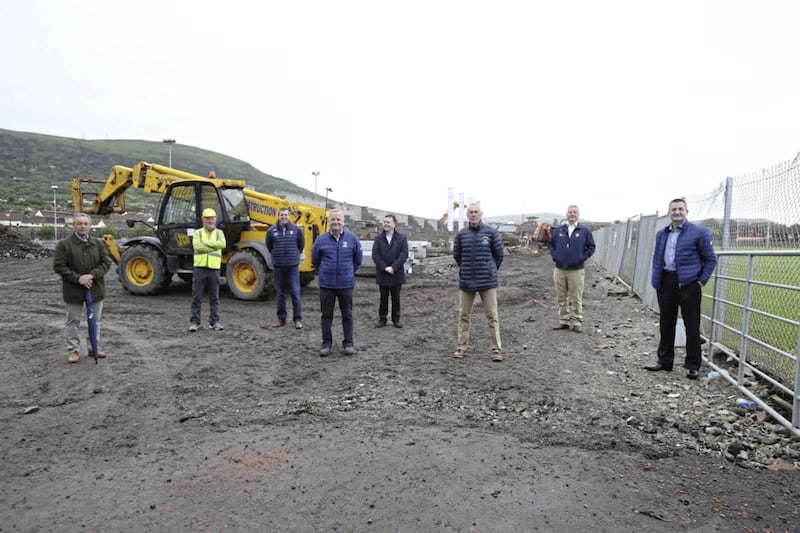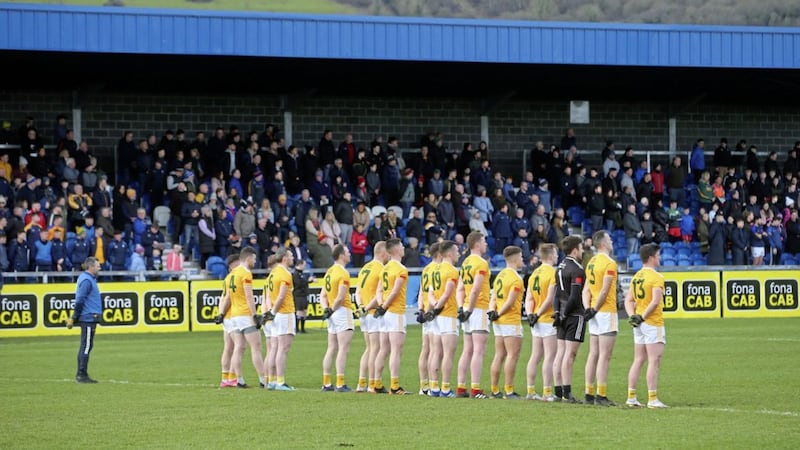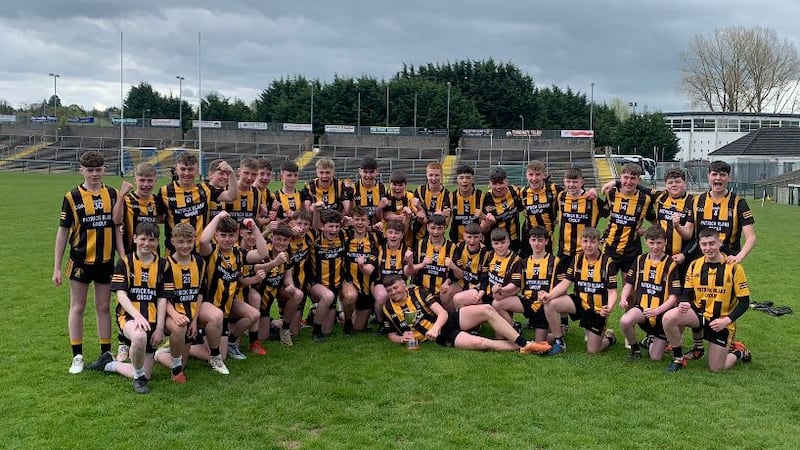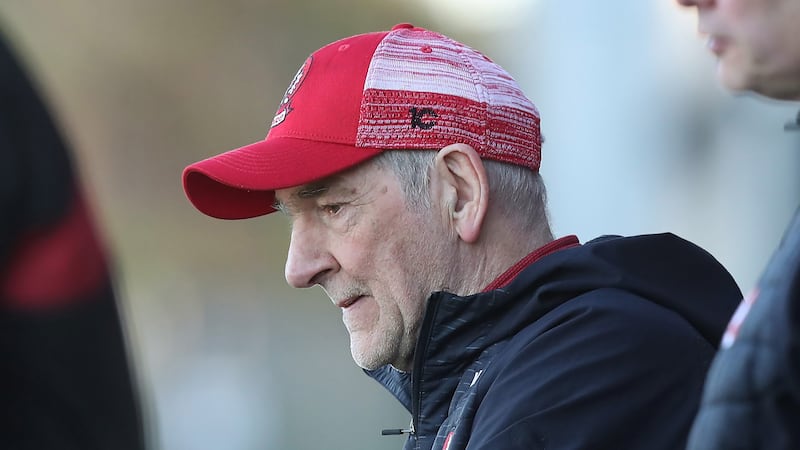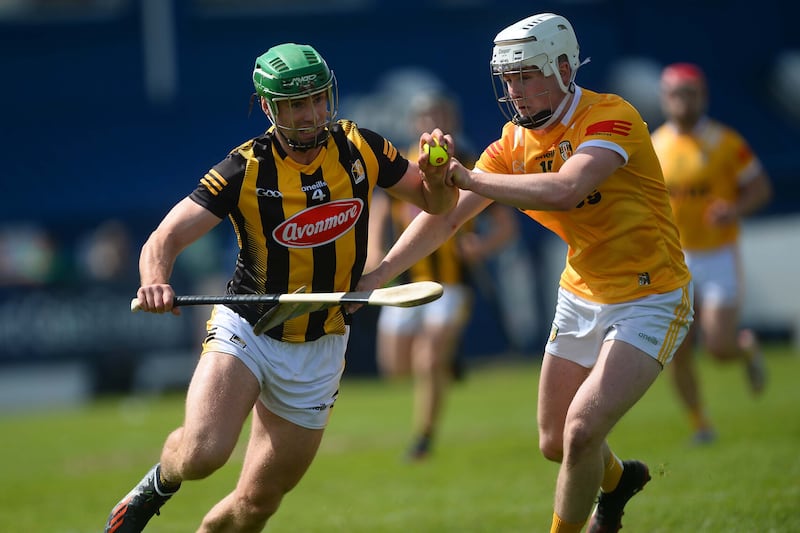“If the stand could talk what tales it could tell as it was steeped in decades of west Belfast Gaelic Games history.” – ‘Come and See the Johnnies play – a history of St John’s GAC, Belfast’, compiled by John and Maria Gough
IT was the back end of January, 1978, when London champions the Kingdom were drawn to face St John’s in the All-Ireland Club SFC quarter-finals at Corrigan Park.
Sitting in one of the alcove seats in the upstairs bar of Corrigan Park, Gerry McCann vividly remembers the crack of gunfire during the game.
“We played out there against the Kingdom and there was a gun battle going on,” says the long-serving St John’s clubman.
“Those boys couldn’t wait to get the match over and get back to London again!”
It’s approaching tea-time on Wednesday afternoon, 10 days out from the Ulster Championship match at the west Belfast ground between Antrim and Cavan.
McCann and Collie Donnelly are waiting on Ulster Council officials to arrive to inspect and, hopefully, rubber-stamp the area behind the goal on the far side where some waste ground has been levelled so that Saturday’s capacity is northwards of 4,000.
A few weeks earlier, Antrim GAA’s refrain of Corrigan-Park-or-nowhere quickly gathered momentum before the Ulster CCC had the good sense to revisit the controversial vote, initiated by Cavan delegates, to move the game away from the Whiterock Road venue despite receiving a £1m facelift during the pandemic.
Before the decision was reversed, Cavan and other county delegates that supported them had to endure something of a public stoning on social media.
The Cavan management team and footballers were unaware of the solo run taking place in the corridors of Ulster, with boss Mickey Graham later stressing that his team had no qualms of playing Antrim in Corrigan.
Walking towards the new all-seater covered stand that holds over 500 people, McCann points beyond its blazing blue structure.
“That’s Ballymurphy Road just there. That takes you right into the bullring and out onto the field where the [Ballymurphy] massacre took place in August 1971. So you’re talking a stone’s throw.”
Corrigan Park and the surrounding area is woven into McCann and Donnelly’s DNA. Its clubrooms are like a Tardis.
We walk through its resplendent rooms, the spacious 3G hall, the framed memories on the stairwell up to The ‘Chatter box’ room where coffee and chat fills the space every Saturday morning.
The main function room's windows offer the perfect panoramic view of the eternal pitch; downstairs at the reception area stands the unmistakable, towering chunk of mahogany wood and the names of past and present club chairmen, dating back to its formation in 1929.
‘Leaders create a legacy’, it declares. From one generation to the next. Tom McLarnon. Bob Foley. Andy McCallin. Frank McCann. Tommy Hall. Patsy Donnelly. Eamon Grieve. Gerry McCann.
You immediately feel a sense of place here.
In their masterfully produced 656-page book charting every aspect of life at the west Belfast GAA club, John and Maria Gough describe Corrigan Park as "an oasis in a concrete city".
The land was purchased by Sean Corrigan and his "fellow pioneers" in 1926 for the princely sum £1,600 for the sole purpose of playing Gaelic Games - three years before the 'Johnnies' were born.
John Cosgrave, who owned a pub at the corner of King Street and Castle Street in Belfast’s city centre, put up the money for the purchase. Antrim and Louth played an exhibition game to officially open the ground on September 12 1926.
Corrigan Park soon became the headquarters of Antrim GAA. In 1929, a new stand was built at a cost of £1,439 which could house 900 people.
No matter what era you delve into at the club, improving the ground was a ceaseless pursuit among those with a passionate interest in GAA.
In 1944, a Corrigan Park Reconstruction Committee was set up with Paddy McNamee, Belfast man Seamus McFerran (both GAA Presidents) and former Irish News editor Robert Kirkwood among its members.
Seven years later, Corrigan Park finally got a water and electric supply.
The illustrious lights of Kerry, Dublin and Tipperary were only too happy to journey north to sample Corrigan.
But, despite hosting many top games, including All-Ireland semi-finals in the 1940s, doubt was cast over the ground’s future when Casement Park - originally named Slemish Park - opened its doors in 1953.
Antrim GAA had found a new home.
In 1955, St John’s GAC rolled the dice, stretched its members to the limit, and assumed responsibility for the up-keep of Corrigan Park.
Fundraising to upgrade its facilities proved torturous throughout the ages, not to mention the handful of malicious fires and vandalism at the premises.
And yet, the club kept pushing forward.
In 1974, a Prunty pitch was laid and new changing facilities were built. The old stand was fire-damaged in 1984 before it had to pulled down in 2014 in the interests of safety.
In November 2001, Corrigan Park was officially recognised as the second county ground which opened a few funding doors.
With the lofty promise of rebuilding Casement Park, the Antrim County Board closed the stadium’s doors in 2013, prematurely many would argue, because they haven’t reopened since.
Antrim GAA were left without a ground with a covered stand and couldn’t legitimately demand home status for an Ulster Championship match – until now.
Ironically, 50 years ago Casement Park’s emergence threatened Corrigan Park’s existence.
Spool forward to the present day with Casement Park still closed and its future not guaranteed, Corrigan has become the hub of Antrim GAA again.
“Even with a new Casement Park we always believed we needed a second county ground in Belfast,” says Donnelly, who served as county chairman between 2016 and 2018 – a period in which Antrim GAA business became more professionalised.
“For us, we always talked about Corrigan being our Parnell Park. Belfast is a major city and is entitled to two county grounds. With Casement stalling, that’s the road we [previous county officers] pushed because we had no county ground and we asked Croke Park to support us in some guise. And, to be fair, [Director-General] Paraic Duffy and [GAA President] John Horan did.”
Without the lobbying efforts of people like Donnelly, Terry Reilly, and the St John’s club, the steadfast commitment of the county’s fundraising bodies and considerable weight of the current county board, Corrigan Park mightn’t have received the upgrade it and Antrim GAA so desperately needed.
“It obviously gives you great satisfaction when you pushed and pushed for it and to see people enjoy the facility,” Donnelly says. “Terry [Reilly] and I often went to meetings after meetings about it. And, to be honest, another six months and we would have been into COVID and we never would have got the funding for the new stand and terracing.”
The feedback St John’s members and Antrim officials have received from hosting National League games in both football and hurling this season re-asserted the county’s convictions that Saturday’s Ulster Championship match against Cavan really was a case of Corrigan Park or no-where.
